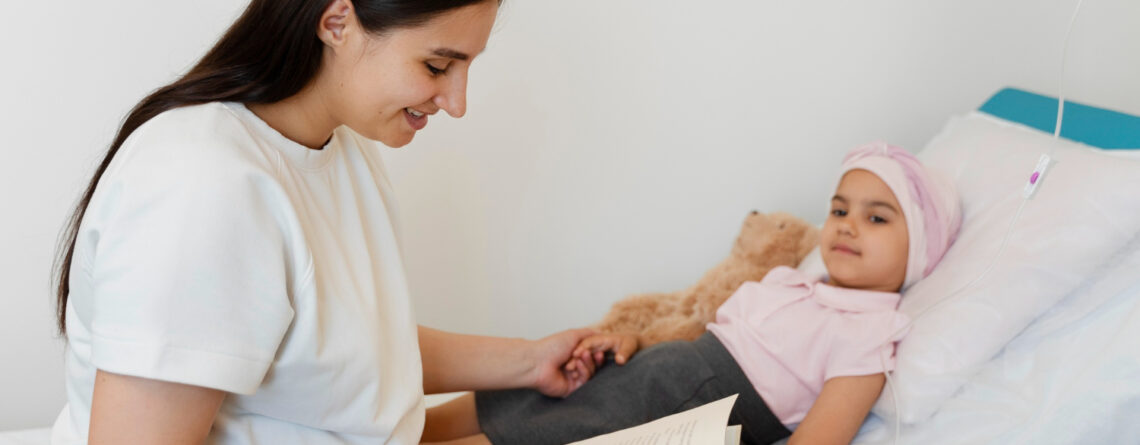Hodgkin's lymphoma (lymphogranulomatosis) is a malignant disease of the lymphatic system (lymph nodes) that develops from the so-called Reed-Sternberg cells and Hodgkin cells, which originate from B-lymphocytes. The cause of the disease is unknown. As a rule, people of young age (20-40 years old) get sick. The disease is rare among children. The difference from other types of lymphoma is the presence in biopsy specimens an abnormal cells of the affected lymph node.
Hodgkin's lymphoma accounts for 6% of all malignant diseases among children. The disease can affect children of any age, but it is extremely rare in the group under 5 years of age. Boys, according to statistical data, get sick more often than girls.

Despite the difficulty of the situation in which young patients and their parents find themselves, there is a way out! After all, the disease can be completely cured. The main thing is not to waste precious time, undergo modern and accurate diagnostics and get into the hands of real specialists in their field. One of these specialists is Israeli doctors. They have achieved extraordinary success in Hematology-Oncology diseases treatment in children, including lymphogranulomatosis.
Maimonides Multidisciplinary Medical Center functions according to the model of modern Israeli medicine. We adopted their medical care model and a patient-oriented approach in all complex diseases treatment. Our Pediatric Hematology project is managed by Professor Amos Toren (the head of the Pediatric Hemato-Oncology and BMT department at the Haim Sheba Israel Medical Center). If we need, all our doctors have the opportunity to consult with Professor Toren, as well as to receive an online consultation for their patients.
The main treatment advantages in Oncology Department Maimonides Multidisciplinary Medical Center are:
- Only doctors with wide practice experience in the field of Pediatric Oncology works in our Clinic. All of them have completed appropriate training on the basis of modern Israelib Pediatric Hematology departments, and are highly qualified. An important feature is a patient-oriented approach to the diagnostic and treatment program. That is, doctors are guided not only by template protocols in their appointments, but take into account the individual characteristics of each patient, his state of health and wishes, regarding the treatment and diagnostic process.
- The department is comfortable for a long stay not only of children, but also of parents or custodians, because the treatment process of Hematology Oncology diseases is long in terms, so it requires the providing of certain conditions. Our Clinic’s wards are equipped with everything necessary, the department has game rooms, buffets, training courses.
- Using only modern and safe medical and diagnostic equipment of the expert class.
- A whole multidisciplinary team is involved in Oncology Department of Maimonides Medical Center The department employs not only pediatric hematologists, but also oncologists, radiation therapists, chemotherapists, infectious disease specialists, rehabilitation specialists, immunologists, pediatricians, psychologists and other specialists whose help a sick child may need.
All Maimonides patients have the opportunity to participate in clinical experimental trials, conducted by leading Israeli clinics, which are absolutely free for them. Sometimes this is the only chance for a further healthy and long life, especially for those children for whom all known treatment methods have turned out to be ineffective.
Hodgkin's lymphoma causes and types
Unfortunately, the true causes of lymphogranulomatosis development are currently unknown. Under the influence of some factor, a genetic breakdown occurs in a certain population of blood B-lymphocytes. It give rise to the malignant line Reed-Sternberg and Hodgkin cells, which settle in the lymph nodes and cause lymphoma’s development.
There are different risk factors for lymphogranulomatosis. Among them:
- Ebstein-Barr virus infection (transmitted infectious mononucleosis in the past);
- primary or secondary immunodeficiency conditions;
- lymphogranulomatosis in family of anamnesis (this disease presence in relatives).
Depending on the histological picture, 2 types of Hodgkin's lymphoma are distinguished (this is important to determine, since the drugs selection for treatment of the disease depends on the type):
- Classic Hodgkin's lymphoma is a variant of nodular sclerosis (70–80% of cases), a mixed cellularity form, lymphocyte depletion, and enriched in lymphocytes. Most cases of classical variants are diagnosed in the early stages of the process, when upper cervical lymph nodes are most often affected. General symptoms are often absent.
- Non-classical Hodgkin's lymphoma (Nodular lymphocyte-predominant) is very rare. This disease characterize by peripheral lymph nodes affection. Its course is slow and benign, usually one group of lymph nodes is affected. Well amenable to treatment, including relapses.
Recovery statistics Hodgkin's lymphoma in children
According to the modern hematological clinics data, 87% of patients diagnosed with lymphogranulomatosis live for 5 years or more. 5-year survival depends on the stage of the disease at which it was discovered. Thus, with stage 1 - 5-year survival is 94%, with stage 2 - 91%, 3 and 4 – 81%.
Thus, the prognosis for lymphogranulomatosis depends on the stageat which the disease is diagnosed. One of the treatment advantages at Maimonides Medical Center is early and accurate diagnosis with modern diagnostic equipment application. That’s is why our patients have excellent recovery rates and subsequent long lives without relapses.

Lymphogranulomatosis symptoms in children
You can suspect the disease in a child by the following signs:
- Nonspecific general symptoms - general weakness, loss of weight and appetite, prolonged high temperature for no apparent reason, skin itching.
- Persistent lymph nodes enlargementwhen it is not possible to identify the causes of this phenomenon. Both peripheral lymph nodes can increase (in this case, you can notice or palpate formations in the child’s body), and internal ones (such lymphadenopathy is most often detected accidentally during internal organs ultrasound for other reasons).
- Symptoms associated with extranodal lesions of the tumor process – liver or spleenlen largement, changes in bones, bladder, skin.
- Symptoms associated with an internal lymph nodes increase - cough, superior vena cava syndrome, shortness of breath, flatulence, constipation, intestinal obstruction.
There are 4 stages 4 stages in the clinical course of the disease:
- One lymph node or 1 anatomical group is affected, or 1 extranodal focus is present without lymph node involvement.
- Two or more lymph nodes anatomical groups on one side of the diaphragm are affected by the pathological process. And stage 1 or 2 for nodal lesions with pathological process limited spread to the adjacent extranodal organ.
- Affected lymph nodes on both sides of the diaphragm or lymph nodes above the diaphragm and simultaneous spleen damage.
- Remote extranodal organ damaged by another, and any damage to lymph nodes are present.
As already mentioned, the prognosis depends on the stage at which the disease was detected, as well as the selected treatment schemes. Therefore, a patient with suspected lymphogranulomatosis should be examined very carefully, not to miss any affected lymph node or organ. Modern diagnostic equipment and the latest medical imaging techniques will help us in this. All this arsenal is actively used in children's hematology following the leading Israeli clinics model.
Hodgkin's lymphoma modern diagnosis methods
Hodgkin's lymphoma can be suspected based on the symptoms described above, but affected lymph node or other organ biopsy and histological examination of the obtained material is required to confirm the diagnosis. It is important to know that all patient’s biopsies at our medical center are sent for revision to the best pathogistological laboratories Israel, USA, and Germany. Thanks to such "molecular checks", we are absolutely sure of diagnosis correctness and the selected treatment scheme appropriateness.
Reed-Sternberg cells and Hodgkin cells are a specific histological finding in a tissue sample for lymphogranulomatosisThis makes it possible to verify the diagnosis with 100% accuracy. Immediately after the histological examination, an immunohistochemical study of the biopsy specimens is conducted. It allows to distinguish different types of receptors on the surface of malignant cells and to choose the most effective treatment regimen based on these data.
Any invasive procedure, including biopsy, in children is provided according to the standards of world pediatric practice under sedation or general anesthesia, this makes it possible that young patients do not experience pain, fear or other psychological discomfort.
All patients must undergo a general blood test and other blood tests if necessary. Unfortunately, peripheral blood reacts to the disease in only 10-15% of patients. In the rest it remains unchanged, which makes it impossible to diagnose the disease during preventive examinations.
During a bone marrow trepan biopsy, changes are also observed relatively rarely – in 6% of patients, specific lymphoma cells can be seen in the bone marrow punctate.
The next step after histological confirmation of the diagnosis is imaging studies, it allow scanning every square centimeter of the body and finding all affected lymph nodes and extranodal organs or ascertaining their absence. For this purpose - CT with contrast, MRI with contrast, PET-CT, digital radiography are used. If Maimonides Clinic does not have certain diagnostic equipment, the patient, together with his parents or custodians, is referred to affiliated medical institutions or Israeli partner clinics for complex diagnostics.
Before starting the treatment program functional tests of heart, lungs, and kidneys must be provided. It is necessary to make sure that the function of these organs is not impaired, because is planned that sufficiently large load would be on them.
If certain extranodal organs are affected, some other examinations may be required. For example: gastroscopy, thoracoscopy, laparoscopy, ultrasound of abdominal organs, kidneys, spinal canal puncture and cerebrospinal fluid testing, etc.

Innovative lymphogranulomatosis treatment at Maimonides Medical Center
Doctors of our medical center are guided by 2 main principles, making up a treatment plan for a small patient with lymphogranulomatosis. First: only the world's best treatment protocols in orderto evidence-based medicine are used. The second: all medical care is personalized, it means that our specialist does not use the template of one treatment scheme for everyone, procedures and drugs are selected individually, taking into account the age of the child, the state of his health, the stage of the disease, the wishes of the parents, the data of histological, immunohistochemical examination, etc.
Chemotherapy
This is the main treatment method for Hodgkin's lymphoma. The essence of this technique is the systemic drugs applying that have an ability to prevent the reproduction or completely destroy malignant cells. The main disadvantage of chemotherapy is that the drugs affect not only on tumor, but also on healthy cells in body, leading to blocking and their reproduction. The main side effects of chemotherapy are related to this. In our practice, we use only tested and high-quality chemical drugs from world-famous manufacturers.
The most widespread chemotherapy scheme for Hodgkin's lymphoma in children are:
- BEACOPP: bleomycin, etoposide, doxorubicin, cyclophosphamide, vincristine, procarbazine, and prednisone.
- Stanford V: doxorubicin, vinblastine, chlormethine, vincristine, bleomycin, etoposide, and prednisone.
- OEPA: vincristine, etoposide, prednisone and doxorubicin.
- COPDAC: cyclophosphamide, vincristine, prednisone, and dacarbazine.
Children's oncology centers are constantly in search of new, more effective and safer chemotherapy drugs, so treatment protocols will change and improve all the time. Our doctors follow all the news and recommendations in this field in order to implement innovations in practice quickly and efficiently.
Radiation therapy
In the past, every course of lymphogranulomatosis treatment included radiation therapy, but with implementation of modern chemotherapy protocols and other biological drugs, radiation therapy is not necessary for all patients. It is used only in certain cases, when the response to treatment with first-line drugs is incomplete.
There are 2 types of radiation therapy:
- Remote (this type is used for lymphogranulomatosis) – when the radiation source is outside the body. For this purpose it is applied special devices – linear accelerators are used. The safer device that is more modern one. Our patients have access only to high-quality and safe devices of the expert class. So they can be sure of treatment effectiveness, after the received course and minimal side effects.
- Contact (brachytherapy) – when radioactive material is placed in a capsule and implanted directly into the tumor tissue. In this way, negative impact of ionizing radiation on the surrounding healthy cells reduces considerable. Att hat time the maximum therapeutic effect in the area of the neoplasm achieved. But in lymphogranulomatosis, brachytherapy is almost never used.

Target therapy and immunotherapy
This type of immunotherapy (biological therapy) is used for some types of Hodgkin's lymphoma. Drugs for targeted therapy have clearly defined effect, they are “trained” to affect certain points of malignant cells, blocking their reproduction or functioning. As a result of such effect, the tumor cell quickly dies. A significant advantage of this drugs class is their selectivity action. It means that they do not affect healthy cells, unlike classical chemotherapy. Among drugs for targeted therapy are brentuximab, pembrolizumab.
Immunotherapy for lymphomas has several varieties. In addition to targeted drugs, there are various monoclonal antibodies, immune response checkpoint inhibitors, CAR-T cell therapy, and small molecule inhibitors.
CAR-T cell therapy is the latest innovation in struggle against hematology oncology diseases, including lymphomas. The production of such drugs requires the best modern genetic engineering laboratory and highly qualified personnel. CAR-T cells are made individually for each patient. To do this, a blood sample is first taken from the patient to separate leukocytes from it. Than, these leukocytes are modified through genetic engineering in such a way that chimeric antigen receptors (CAR) appear on their surface in accordance with the type of tumor cells found in the same patient. Further, such “modernized” cells are multiplied by cloning and returned to the patient's blood, where they actively “track” them down and destroy.
Hematopoietic stem cells transplantation
Bone marrow transplantation, or hematopoietic stem cells transplantation, is a modern ]Hematology Oncology diseases treatment method. It is not one of the main treatments for Hodgkin's lymphoma, but it can be used if there is no response to first-line treatment.
Transplantation can be autologouswhen the patient become a donor himself before the entire treatment course starts. And allogeneic, when the donor is a relative or any other person who meets certain parameters.
The procedure of hematopoietic stem cells transplantation is complex, requires applying of modern equipment and qualified doctors with experience in this field of medicine. So you need to trust only proven specialists and medical institutions. One of these is the Maimonides Multidisciplinary Medical Center and its partner Israeli medical institutions.
